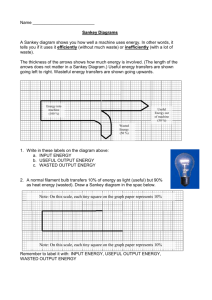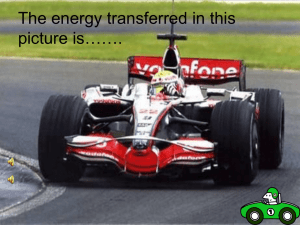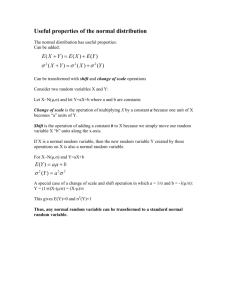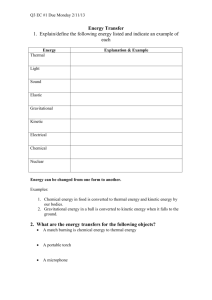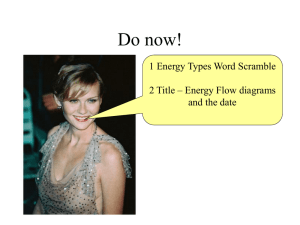GCSE P1 1.2.1 Energy Transfers and Efficiency
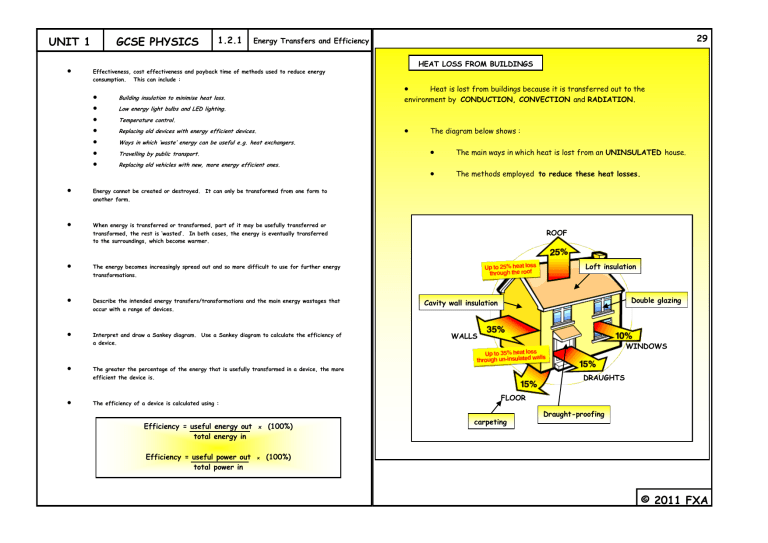
UNIT 1 GCSE PHYSICS
1.2.1
Energy Transfers and Efficiency
Effectiveness, cost effectiveness and payback time of methods used to reduce energy consumption. This can include :
Building insulation to minimise heat loss.
Low energy light bulbs and LED lighting.
Temperature control.
Replacing old devices with energy efficient devices.
Ways in which ‘waste’ energy can be useful e.g. heat exchangers.
Travelling by public transport.
Replacing old vehicles with new, more energy efficient ones.
Energy cannot be created or destroyed. It can only be transformed from one form to another form.
When energy is transferred or transformed, part of it may be usefully transferred or transformed, the rest is ‘wasted’. In both cases, the energy is eventually transferred to the surroundings, which become warmer.
The energy becomes increasingly spread out and so more difficult to use for further energy transformations.
Describe the intended energy transfers/transformations and the main energy wastages that occur with a range of devices.
Interpret and draw a Sankey diagram. Use a Sankey diagram to calculate the efficiency of a device.
The greater the percentage of the energy that is usefully transformed in a device, the more efficient the device is.
The efficiency of a device is calculated using :
Efficiency = useful energy out x
(100%)
total energy in
Efficiency = useful power out x
(100%) total power in
HEAT LOSS FROM BUILDINGS
Heat is lost from buildings because it is transferred out to the environment by CONDUCTION, CONVECTION and RADIATION.
The diagram below shows :
The main ways in which heat is lost from an UNINSULATED house.
The methods employed to reduce these heat losses.
29
ROOF
Loft insulation
Double glazing
Cavity wall insulation
WALLS
DRAUGHTS
FLOOR
carpeting
Draught-proofing
WINDOWS
© 2011 FXA
UNIT 1 GCSE PHYSICS
1.2.1
Energy Transfers and Efficiency
HEAT LOSS REDUCTION METHODS
1. DOUBLE GLAZING
This consists of two sheets of glass with a layer of trapped air in between.
air trapped
between the two glass panes
The air is an excellent insulator and the glass is also an insulator, so this reduces heat loss by ……………………………………………….
The fact that the air is trapped means that it cannot move and so heat loss by
……………………………………………. is also reduced.
The heat loss is reduced from 10% to 5%, giving an annual saving of
about £100 for an installation cost of about £4000.
PAYBACK TIME :
2. LOFT INSULATION
A thick layer of fibreglass wool is laid between the floor joists in the loft.
This acts as an excellent insulator which reduces heat loss by
………………………………………………. and the fact that the air in the wool cannot move also means that heat loss by
…………………………………………. is also reduced.
The heat loss is reduced from 25% to 5%, giving an annual saving of about
£200 for an installation cost of about £600.
PAYBACK TIME :
3.
CAVITY WALL INSULATION
Insulating foam is injected into the cavity between the outer brick wall and the inner breeze block wall.
The air which is trapped in the foam acts as an insulating layer which reduces heat loss by
………………………………………………. and the fact that the air is unable to move minimizes heat loss by
………………………………………………..
The heat loss is reduced from 35% to 15% , giving an annual saving of
about £150 for an installation cost of about £1000.
PAYBACK TIME :
4.
FLOOR INSULATION
Thick carpeting with its underlay provides a layer of thermal insulation which reduces heat loss by ……………………………………………..
The heat loss is reduced from 15% to 5%, giving an annual saving of
about £100 for an installation cost of about £1000.
PAYBACK TIME :
5. DRAUGHT-PROOFING
Strips of plastic and foam are glued around door frames and windows so as to stop cold draughts of air blowing into the house.
The heat loss is reduced from 15% to 5% , giving an annual saving of
about £50 for an installation cost of £25.
PAYBACK TIME :
30
© 2011 FXA
UNIT 1 GCSE PHYSICS
1.2.1
Energy Transfers and Efficiency
“EFFECTIVENESS” AND “COST EFFECTIVENESS”
The most “EFFECTIVE” methods for reducing heat loss are those which give the greatest saving per annum.
Write down the heat loss reduction methods we have described in descending
order of “EFFECTIVENESS”.
Most effective ……….. 1
2
3
Least effective ……….
4
5
The “COST EFFECTIVENESS” or “PAYBACK TIME” is calculated from :
PAYBACK TIME (YEARS) = INITIAL COST
SAVING PER ANNUM
Write down the heat loss reduction methods we have described in descending
order of “COST EFFECTIVENESS”.
Most effective ……….. 1
2
3
4
Least effective ………. 5
OTHER WAYS OF IMPROVING ENERGY EFFICIENCY
There are other things which we can do to improve energy efficiency in our homes, schools and places of work.
Thermostats and computer control systems for central heating can further reduce the heating needs of a building. They stop rooms from being heated too much by switching the heating off when a specific optimum temperature is reached.
Energy saving light bulbs can give the same light brightness as incandescent filament bulbs using a lot less energy.
A 40 W energy saving bulb will give out the same amount of light as a 150 W filament bulb.
They also have the added advantage of a much longer lifespan ( 6000—15000 hours compared to the maximum 1000 hours of ordinary bulbs).
A light-emitting diode (LED) is a semiconductor light source.
LED’s are used as indicator lamps in a huge variety of electrical devices (e.g. TV sets, DVD players etc.) and because modern versions can give very bright light, they are increasingly being used in lighting.
LED lighting has a much lower energy consumption than ordinary light bulbs or fluorescent tubes and although it is relatively expensive, it has a very long lifespan and it is very reliable.
31
© 2011 FXA
UNIT 1 GCSE PHYSICS
1.2.1
Energy Transfers and Efficiency
Heat exchangers are devices used to transfer heat from one fluid to another.
Warmer clean
water
hot dirty
water
Cold clean
water
cooler dirty
water
copper
pipes
People who are really serious about reducing their carbon footprint and also saving money can use an energy monitor to check their daily energy use and hence take steps to improve their energy efficiency.
These meters show how much electrical energy is being used in a home and the effect of turning things on and off.
The diagram above shows a double pipe heat exchanger of the type used to improve energy efficiency in hospital laundry systems. Hot dirty water from the washing flows along the central pipe and clean cold water is passed through a cylindrical jacket surrounding the hot pipe. In this way, heat is transferred to the clean water which then requires less heating for use in the washing process.
The heat from the hot dirty water is transferred through the pipe wall by conduction. So the pipe is made of a good thermal conductor (copper) and its wall is of large surface area and thin so as to maximise conduction. The heat is then transferred through the cold water by convection.
More heat is extracted from the hot water if it flows slowly through the heat exchanger.
Energy efficiency can also be improved by replacing older electrical appliances with more modern, energy efficient versions.
Turning the TV, DVD player or games console off when it is not in use saves energy and reduces harmful CO
2
emissions. In the UK around 15 million
TV’s are left on standby for 20 hours a day. If they were all switched off we would save enough energy to decommission an entire power station.
There are now devices available which will prevents anything being left on standby by automatically switching things off when they are not in use.
32
© 2011 FXA
UNIT 1
ENERGY
GCSE PHYSICS
1.2.1
Energy Transfers and Efficiency
Is the capacity of a body for doing work.
Is measured in : JOULE ( J )
CANNOT BE CREATED OR DESTROYED BUT IT CAN
BE CONVERTED FROM ONE FORM INTO ANOTHER
This is the The principle of conservation of energy
Exists in a variety of different forms :
FORMS OF ENERGY
MECHANICAL ENERGY
KINETIC ENERGY
This is the energy possessed by a moving object.
GRAVITATIONAL POTENTIAL ENERGY
This is the energy a body has as a result of its position or height above the ground.
ELASTIC POTENTIAL ENERGY
This is the energy stored in a body as a result of being stretched or compressed.
LIGHT ENERGY
HEAT (THERMAL) ENERGY
ELECTRICAL ENERGY
CHEMICAL ENERGY
SOUND ENERGY
NUCLEAR ENERGY
ENERGY TRANSFORMATIONS
Energy changes can be shown using an ENERGY FLOW DIAGRAM.
Example : When a torch battery drives a current through the bulb, the filament of the bulb gives out heat and light.
The flow diagram is as shown below :
chemical energy in
the battery
electrical energy
light energy and
thermal energy
Complete the following energy flow diagrams :
(1) A book falls from a shelf and hits the floor with a thud.
gravitational
potential energy
(2) A car engine when it is running.
chemical energy
stored in the fuel
33
© 2011 FXA
UNIT 1 GCSE PHYSICS
USEFUL AND WASTED ENERGY
1.2.1
Energy Transfers and Efficiency
When a device transfers energy, only part of the energy is usefully transferred to where it is wanted and in the form that’s wanted.
The rest of the energy is transformed in a non-useful way, mainly as heat and sound energy. This non-useful energy is called wasted energy. energy
input
DEVICE or
MACHINE
useful energy
output wasted energy
(heat and sound)
The wasted energy and the useful energy eventually end up warming the air around us. In this way the energy becomes more and more spread out into the surroundings and it is then more difficult to use for further energy transfers.
The efficiency of a device refers to the proportion of the input energy which the device transforms into useful output energy.
The greater the efficiency, the greater is the proportion of the input energy which is transformed into useful energy.
34
The efficiency of a device, expressed as either a percentage or a decimal number, is calculated using the following equations : efficiency = useful energy out (x 100%)
total energy in
AND efficiency = useful power out (x 100%)
total power in
Some energy is always ‘wasted’ so no device is 100% efficient.
The ‘wasted’ energy is nearly always dissipated as heat and sound.
Electric heaters are the exception, since all the electrical energy supplied is transformed into useful heat energy (although in practice some is transformed into non-useful light energy).
Use the efficiency formula to complete the table below :
Total energy
Input (J)
2000
useful energy output (J)
1500
% effficiency
6000
250
2000
200
60
15
© 2011 FXA
UNIT 1 GCSE PHYSICS
1.2.1
Energy Transfers and Efficiency
ENERGY TRANSFER EXAMPLES
Complete the table of energy transfers shown below :
DEVICE ENERGY
INPUT
USEFUL ENERGY
OUTPUT filament bulb
‘WASTED’
ENERGY car engine loudspeaker bow and arrow wind turbine hair drier electric fan electric heater television set gas cooker ring wind-up radio
ENERGY ARROW (SANKEY) DIAGRAMS
These diagrams give us a very clear picture of an energy transfer situation.
The width of each segment of the arrow shows the proportion of the input energy which has been transformed into each different form.
The Efficiency of a given device can then be worked out from such a diagram.
Fig.1 opposite is the
Sankey diagram for an ordinary filament bulb.
Its % efficiency is :
10 x 100 =
100
10%
Fig.2 is the Sankey diagram for a modern energy efficient light bulb.
Its % efficiency is :
75 x 100 =
100
75%
Fig.1
Fig.2
35
© 2011 FXA
UNIT 1 GCSE PHYSICS
1.2.1
Energy Transfers and Efficiency
In exams, the Sankey diagram is drawn on graph paper and you will need to count squares on the grid in order to work out how much of the energy supplied has been transferred into useful energy and wasted energy.
The % efficiency can then be calculated using the normal % efficiency formula.
The diagram below is an example of what you might be faced with in the exam.
It is the Sankey diagram for an internal combustion engine. The useful energy is the kinetic energy and the sound and heat energy produced is
‘wasted’ energy.
% efficiency = useful energy output x 100 = 1 x 100 =
total energy input 10
10 %
The Sankey diagram for an ipod is shown below. Calculate :
(a) Its efficiency , simply as a decimal.
(b) Its % efficiency
36
© 2011 FXA
UNIT 1 GCSE PHYSICS
PRACTICAL INVESTIGATION - EFFICIENCY OF AN ELECTRIC MOTOR
The apparatus is set up as shown in the diagram opposite and the electric motor is used to lift the slotted masses through a measured height, h.
h = m
A stopclock is used to measure the time, t taken for the masses to be lifted through height h. t = s
I = A
A
1.2.1
Energy Transfers and Efficiency
The current, I in the motor and the potential difference, V across it are also measured using an ammeter and voltmeter respectively.
=
Gravitational potential energy gained by = m x g x h
the lifted masses, E
O
= x x
= J
% efficiency of the motor = (E
O
/E
I
) x 100
= x 100
=
+
electric motor
V = V
V
Electrical energy supplied to the motor, E
I
= V x I x t
-
= x x
low voltage
d.c. supply
J
%
slotted masses
4
5
2
3
1
PRACTICE QUESTIONS
37
The devices listed below transfer energy in different ways.
1. Car engine 2. Electric bell 3. Electric light bulb 4. Gas heater
Match words A, B, C and D with the devices numbered 1 to 4.
A. Heat (thermal) energy
C. Movement (kinetic) energy
B. Light energy
D. Sound energy
Use words from the list to complete the sentences given below :
USEFUL WASTED THERMAL LIGHT ELECTRICAL
When a light bulb is switched on …………………………… energy is changed into ………………………….. energy and into ……………………………………. energy of the surroundings. The energy that radiates from the light bulb is ………………………………….. energy. The rest of the energy supplied to the light bulb is …………………………………………. energy.
On a building site a machine is used to lift a bag of sand from the ground to the top of a building. What type of energy has the bag of sand gained ?
A. Elastic potential energy
C. Kinetic energy
B. Gravitational potential energy
D. Thermal energy
What type of energy is stored in a stretched rubber band ?
A. Chemical energy
C. Gravitational potential energy
B. Elastic strain energy
D. Kinetic energy
An electric fan is used to move air around a room.
(a) The fan usefully transforms electrical energy into :
A. Elastic energy
C. kinetic energy
B. heat energy
D. Sound energy
© 2011 FXA
7
6
UNIT 1 GCSE PHYSICS
1.2.1
Energy Transfers and Efficiency
(b) Energy that is not usefully transformed by the fan is wasted as :
A. Heat and sound energy
C. Kinetic and sound energy
A. It makes the surroundings warmer
B. It can no longer be transformed in useful ways
C. It becomes very thinly spread out
D. It makes the surroundings cooler
A. Is 100% efficient
C. Is more efficient
A chair lift carries skiers to the top of a mountain.
B. Heat energy only
D. Sound energy only
(c) Which of the following statements about the energy wasted by the fan is not true?
(d) A second design of fan transforms useful energy at the same rate, but wastes
less of the energy supplied to it. This means that the second fan :
B. Is less efficient
D. Has the same efficiency
(a) When the skiers get to the top of the mountain they have gained gravitational
potential energy. As they ski back down the mountain, what type of energy is this
transformed into?
(b) The chair lift is powered by an electric motor. What useful energy transformation
takes place in the motor?
(c) Some of the electrical energy supplied to the motor is wasted as heat. Why does
this happen?
(d) The energy required to lift two skiers to the top of the mountain is 240 000J.
The energy supplied to the motor is 800 000 J. Calculate the % efficiency of
the motor.
A car engine is found to be 21% efficient. If the total energy supplied to the engine in a given time is 750 000 J, calculate how much of this is usefully transformed.
The fraction of the energy supplied to the engine which is not usefully transformed is called the wasted energy. Name the two forms of energy produced by the engine which are classed as wasted energy.
An electric motor is used to raise a weight. When 60 J of electrical energy is supplied to the motor, the weight gains 24 J of gravitational potential energy.
38
9
8
(a)
(b)
What is the
Complete the table shown below to show what happens to the energy transferred in each case. energy wasted
Calculate the % efficiency
ENERGY TRANSFER BY :
An electric motor
A television set
An electric kettle
Headphones by the motor? of the motor.
USEFUL ENERGY WASTED ENERGY
10 When a television set is supplied with 2000 J of electrical energy, it produces 1190 J of light energy, 800 J of thermal energy and 10 J of sound energy.
(a) What form of energy is transferred as waste energy by the television set?
(b) What does the waste energy do to the air around the television set?
(c) Calculate the efficiency of this television set :
(i)
(ii)
As
As a decimal. a percentage.
© 2011 FXA
3
2
1
4
UNIT 1 GCSE PHYSICS
HOMEWORK QUESTIONS (1)
Heat is lost from a house through its roof, walls, windows, floor and doors.
Write down one measure which could be taken to reduce thermal energy loss through each part of the house.
Explain briefly how each of the following methods of insulation work :
(a) Loft insulation, (b) Cavity wall insulation.
When we are discussing the relative benefits of heat loss reduction methods for a house, the terms ‘effective’, ‘cost effective’ and ‘payback time’ are used.
Explain what each of these terms means. method of reducing energy loss
Draught-proofing
Hot-water tank jacket
Loft insulation
Thermostatic control on radiators
1.2.1
Energy Transfers and Efficiency
The table below gives information about ways of reducing energy loss from a house. fitting cost annual saving
(a) Which method of reducing energy loss saves money by preventing the house
becoming too warm?
(b) Which method reduces energy loss by the smallest amount?
(c) Which method pays for itself in the shortest time?
(d) What is the payback time on loft insulation?
£80
£25
£400
£150
£80
£20
£80
£30
7
6
5
The Sankey diagram opposite shows the energy changes in a
Lego toy car.
(a) How much energy does one
small square represent?
(b) How much energy is wasted?
(c) What energy forms is this
wasted energy mostly likely
to take?
(d) Calculate the % efficiency
of the toy car.
200 J
Input
50 J
Useful output
BMW are testing a new, revolutionary, high-efficiency engine for their latest car.
It is found that for every 1000 J of energy supplied to the engine, 750 J are transformed into kinetic energy in the moving car, 5 J are wasted as sound energy and the rest is is transformed into waste thermal energy.
(a) Using graph paper, draw a Sankey energy transformation diagram to illustrate
the results of BMW’s research.
(b) Calculate the % efficiency of this new engine.
(a) Name the two forms of useful energy transferred by a laptop p.c.
What energy form is ‘ wasted’ energy in a laptop p.c.?
(b) Which of the statements shown below about the energy transfer in a laptop
is false?
(i) The energy is spread out to the environment.
(ii) The energy is used up.
(iii) The energy warms up the surroundings.
(iv) It is difficult to use the energy again.
Waste
(c) A laptop uses 1500 J/s of energy of which only 950 J/s is usefully transferred.
Calculate the % efficiency of the laptop.
39
© 2011 FXA
